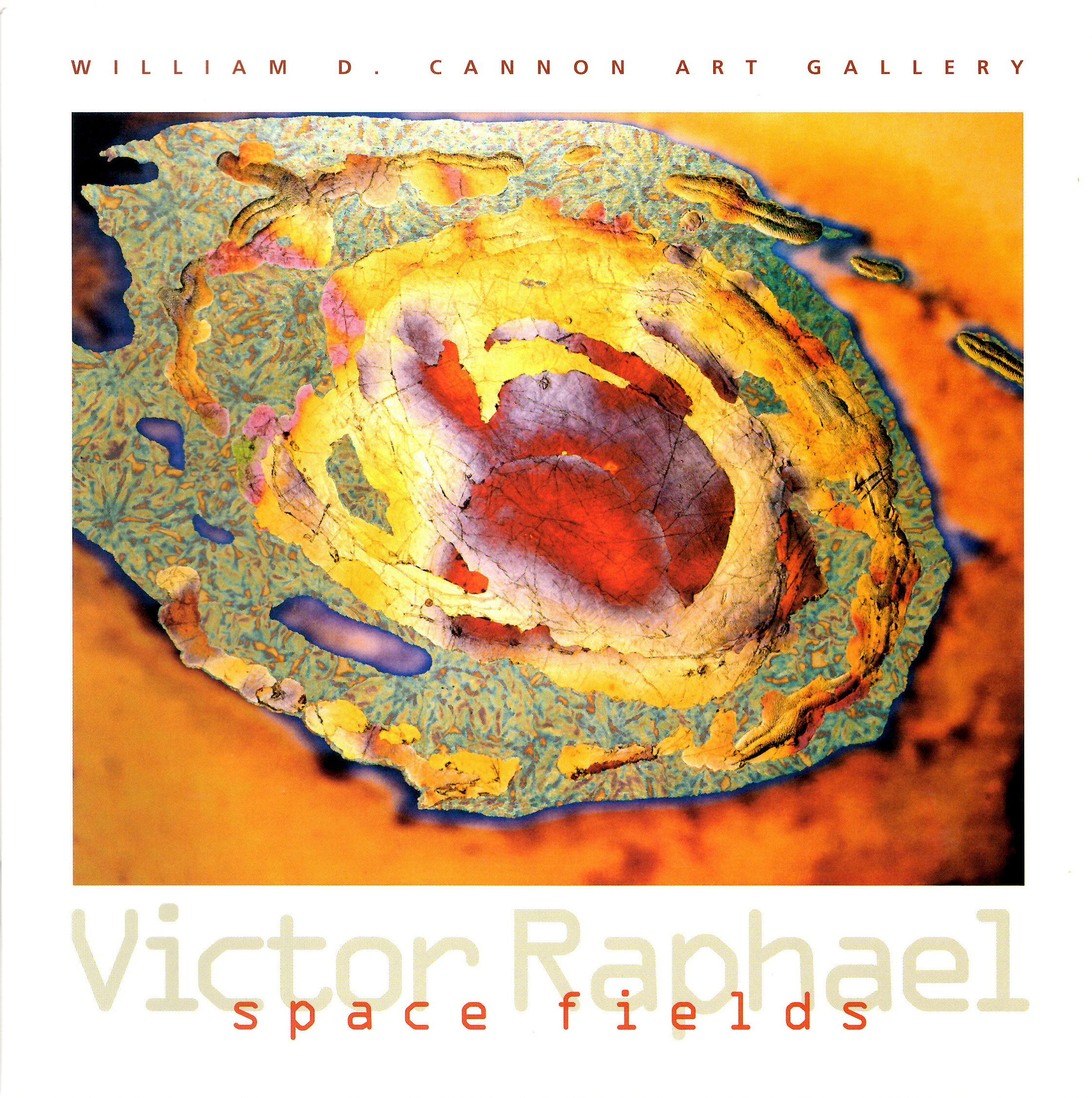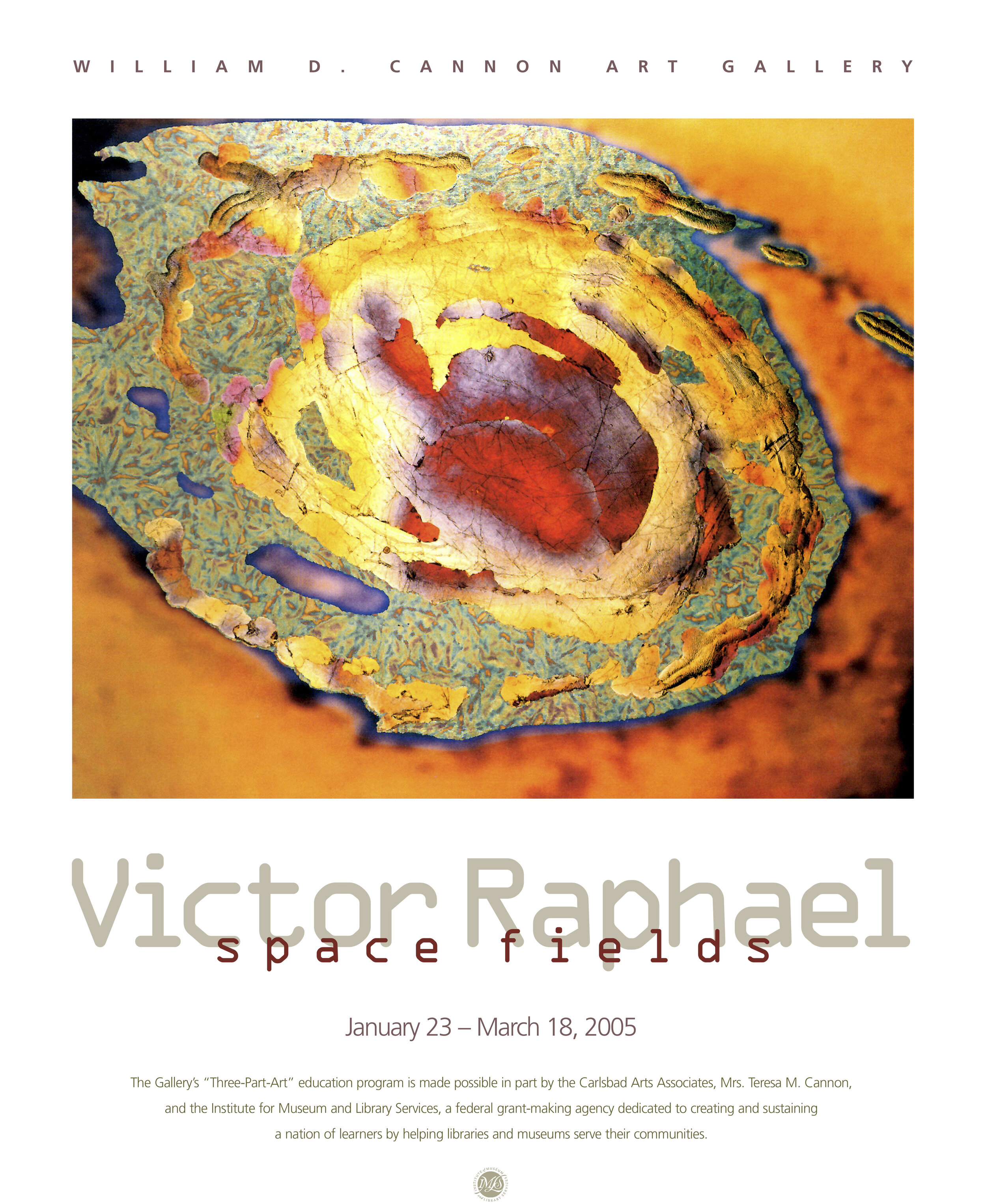WILLIAM D. CANNON ART GALLERY
VICTOR RAPHAEL - SPACE FIELDS
William D. Cannon Art Gallery, City of Carlsbad, CA, January 23 - March 18, 2005
“When I was a kid growing up in the 1950's, I was excited about the prospect of being an astronaut and going out into space...I think that working with these space images was a way for me to put myself out there and create my own fantasy about space.” - Victor Raphael, A Creative Journey CD-ROM
photo by Andrew Marino
Since the first U.S. manned space flight in 1961, humans and machines have explored the solar system, reaching out to the Sun, the Moon, the planets and beyond. For many of us, the drama and excitement of space exploration took place in our own living rooms, where we watched NASA broadcasts on television and saw photographs of outer space for the first time. The imagery was breathtaking, and the impact of what had been achieved was enormous. Enthralled and awestruck, we watched as rockets carrying sophisticated instruments thundered across the new frontier. These spectacular achievements fired the imagination of people across the nation and all over the world and opened the minds of many individuals to explore and to dream.
This exhibition, Victor Raphael: Space Fields, has much of the same energy as those early NASA programs. Because Raphael was inspired by photo-based images that appeared on televised NASA programs, it seems natural and fitting that he now uses both photography and the television as the conduit for his art. Images on the television screen become both the inspiration and the vehicle by which he begins his work. From exquisite, jewel-like Polaroids to large-scale canvases to Iris prints to a multi-dimensional CD-ROM project, Raphael explores a variety of media and creative techniques. Fiftyeight works of art comprise Victor Raphael: Space Fields with processes that include photography, paint, paper, computers, and printmaking. The result is a stunning visual journey into outer space and into the imaginative world of Victor Raphael.
I want to thank the following individuals and organizations that made this exhibition and catalogue possible. First and Foremost, thank you to Teresa M. Cannon and the Carlsbad Arts Associates for their ongoing commitment and support of the programs of the Cultural Arts Office and the William D. Cannon Art Gallery. A special thank you to Barbara Hitchcock, Director of Cultural Affairs for the Polaroid Collections for writing the introduction. Thanks go to Leah Roschke for designing this beautiful catalogue and poster. Funding for the poster, which was developed for the students and teachers participating in the Three-Part-Art outreach program, was provided by a “Museums for America” grant from the Institute of Museum and Library Services, a federal grant-making agency. Thank you to Michael Zakian at the Weisman Museum, Pepperdine University for agreeing to loan Victor’s iconic work, Planet Field. I am grateful to the Gallery Committee, the Carlsbad Arts Commission, and all the gallery volunteers for their backing and participation, and to members of the Cultural Arts Office Staff, who continue to do terrific work with energy and passion. Finally, a special thank you to Victor Raphael for his enthusiasm, creativity and the countless hours he devoted to the project. Because of his dedication to arts education, he encouraged me to postpone his original exhibition dates in order to take part in the gallery’s exciting Three-Part-Art education program. The Three-Part-Art program includes complete classroom curricula, guided gallery tours, and hands-on art projects for elementary school students for three exhibitions during the year. Over 2,000 students, parents and teachers will participate in the program during Victor Raphael: Space Fields. Victor also generously burned over 90 CD’s of his CD-ROM project “A Creative Journey” that were included in the curriculum resource guides.
It is with great pleasure that the William D. Cannon Art Gallery presents this body of work in both exhibition and publication form. We hope you find it inspiring, thought-provoking and extraordinary.
Karen McGuire, Curator
Three-Part-Art program photo by Tonya Rodzack
photo by Bob Goldstein
photo by Andrew Marino
photo by Andrew Marino






